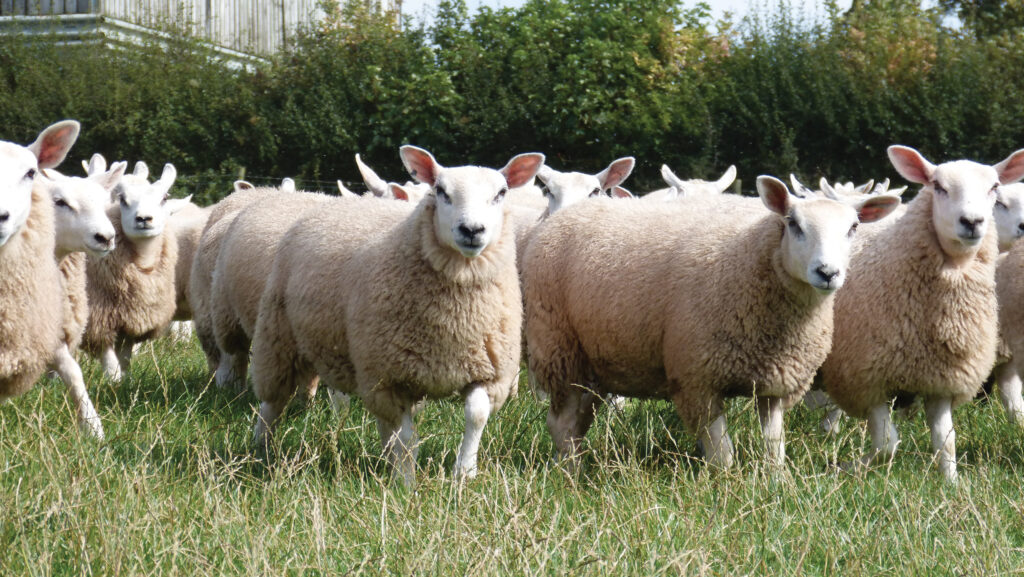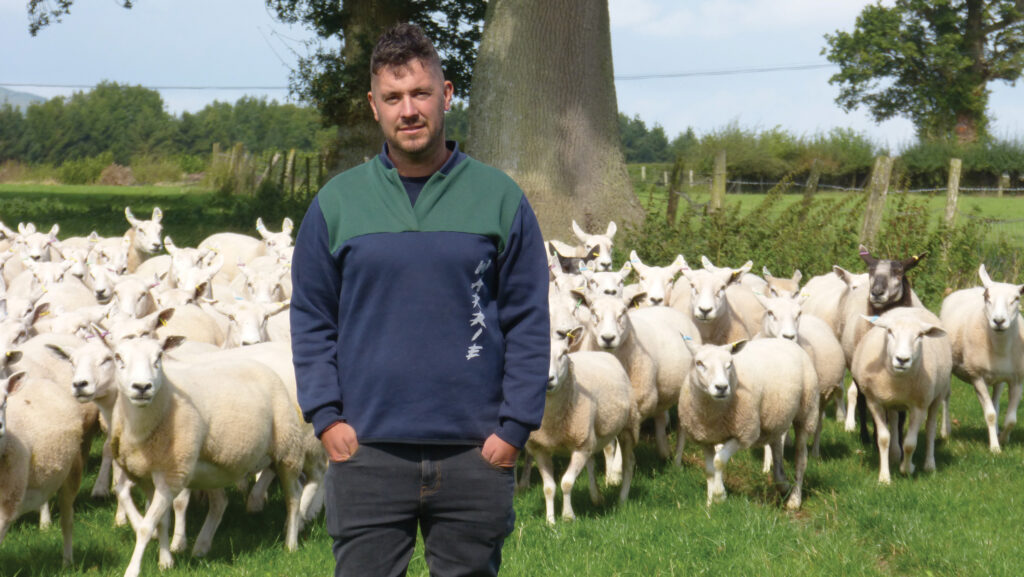How a mixed farm trebled ewe flock on high-input system
 © MAG/Michael Priestley
© MAG/Michael Priestley A mixed farm has stuck to a high-input strategy after trebling its flock size and increasing arable ground.
George Evans of Day House Farm, Stottesdon, Shropshire, is curious about lower input, lower cost methods, but says his current strategy works well and complements the arable unit.
Farming with parents Michael and Eunice, and brother Charlie, who runs the arable operation, George oversees 1,200 Welsh Mule and Texel cross Mule ewes.
His aim is to produce the most saleable lambs he can in a system that can grow, take on grazing land and fit in around Charlie’s arable operation.
In recent years, the family have doubled the area they farm by taking on 65ha (161 acres) of arable land on a tenanted farm in 2012 – which they went on to buy in 2021 – and renting 90ha (222 acres) from the neighbouring farm.
See also: Closed policy yields 1.7 lambs reared for Durham flock
Farm Facts

George Evans ©MAG/Michael Priestley
Day House Farm, Shropshire
- 303ha farmed
- 1,200 ewes on 142ha
- White-faced Welsh Mules and Texel crosses
- Indoor lambing from 1 March
- Wintering on 40ha stubble turnips
- 24ha fodder beet – about 1,000t sold
- 161ha arable, growing wheat, barley and oats
- Home farm on tenancy on Boyne Estate
- Two holiday cottages and campsite
- Seven carp ponds
System
The new arable unit means the 80ha (198 acres) of grazing at Day House Farm is used for 600 or so sheep and lambs in summer, with another 600 on 60ha (148 acres) of summer grazing lets further afield.
The flock typically scans at 180% and rears 165-170% (excluding pet lambs). Ewes are turned out with a maximum of two lambs.
About 60-100 pet lambs are reared inside on a milk machine, creep fed and sold at 40kg.
Best-conformation (E and U grade) lambs are sent to Bridgnorth market, and lower conformation and Mule-cross lambs are sold deadweight to ABP.
As of the start of September, the average lamb price at Bridgnorth was £142 (before stoppages).
Sheep are rotated round fields on weekly moves. The home farm has been drilled almost entirely with herbal leys (SAM3), which George subdivides for two to three day moves where possible.
Cull ewes are used to hoover parasites after weaned lambs.
George lists some factors that help make the high-input system work:
Turnip wintering
Breeding sheep and light store lambs are carried through winter on 40ha (99 acres) of stubble turnips. This costs £56/ha for seed and fertiliser, and £120/ha (£4,800 total including machinery use).
However, feeding turnips has saved four weeks of feeding ewe nuts (£2,688) to twins and triplets pre-lambing.
It also rests spring paddocks for 120 days so ewe nuts do not need to be fed after lambing, and it lifts soil fertility in the arable field for the following spring crop.
Focused creep use
Texel-cross ewes and ewe lambs are farmed at home. Their lambs are prioritised for creep feeding because they convert feed better than lambs out of Mules.
This policy also avoids carting feed out to the Mules, which tend to be kept on grass lets further afield.
Limited housing period
Ewes are housed based on raddle markings, which are changed three times (after 10, 17 and 24 days of breeding).
Ewes are transitioned onto ewe rolls for a week on grass at Day House after coming off turnips and then housed. Once lambed, ewes are in a mothering pen for 24 hours before turning outside.
Evidence-based treatments
Blood testing for mineral status at weaning helps inform mineral supplementation. A selenium and cobalt bolus (£1/dose) is used pre-tupping, and a pre-lambing mineral drench is given most years.
Rock salt is offered at pasture (the flock does not vaccinate for orf). Midsummer faecal egg counts (FECs) have halved worming decisions.
Flock health club
Membership of Severn Edge Vets flock health club provides an annual flock health planning visit, unlimited FECs, discounted blood testing and drugs, and group meetings, for £27 a month.
Vaccinations
Precautionary measures are taken against disease to help safeguard flock productivity.
Ewe lambs receive vaccinations for enzootic abortion (£3.06), toxoplasmosis (£5.30) and foot-rot (£1.19), as well as a pasteurella and clostridials vaccine (£1.76 for two doses).
This costs £11.31 for the first year and £2.05 thereafter for foot-rot and clostridial boosters.
Arable integration
Rolled barley is used from the arable shed, valued at opportunity cost of sale. A mobile mixer comes on farm to roll and mix the barley, which is fed, along with a bought-in protein pellet, to finishing lambs through the summer.
This costs £230/t all in. About 100t of home-grown fodder beet (valued at £35/t) is fed at turnout, minimising ewe nut use (£300/t).
Managing market risk
Selling lambs at different times of year – Beltexes earlier (at 38kg), Texels through the summer (at 43kg) and Mule-crosses in March (at 50kg) – spreads risk.
Biosecurity
Incoming Mules are given a group 4-AD orange drench on arrival to minimise wormer resistance and the introduction of new parasites, then foot-bathed and held inside for three days.
They then go onto clean winter grazing and are monitored for disease, only encountering the rest of the flock in late December.
Future
George has bought three Charollais rams this autumn to compare performance with the Texel in a bid to lower days to slaughter through genetic gain and increased hybrid vigour.
“Getting lambs off farm quickly is important for grass availability as much as anything. Lamb prices don’t fall away in August and September like they used to, but speed still matters,” he says.
He is also interested in buying a maternal, forage-reared ram to breed his own replacements to pit them against the Mules.
Shedding genetics and lambing later outside are other options to consider if the high-input system feels cost pressure in the future, he adds.
Flock expansion
Previously, George’s father, Michael, produced store lambs from Beulah draft ewes before moving to a Beulah Speckled Face Mule.
More recently, George has continued using stratified sheep breeds, but opted for a white-faced Welsh Mule (Welsh Mountain cross traditional Bluefaced Leicester) bought from Welshpool.
He retains the pick of the home-bred Texel cross gimmer lambs each year and tups them to home-bred Beltex rams as ewe lambs, and Texels – bought from Hardwicke and Ashledge – thereafter.
“Lamb buyers at the market like white-faced lambs, which is why the current breed choice works,” explains George.
When George left school, he bought a mobile handling system and fencing system. This enabled him to travel to graze summer lets and winter keep up to five miles away.
From a starting flock of 400 ewes – bought when the farm went out of dairy in 2003 – he tripled numbers by keeping 200 ewe lambs a year, buying 150 Welsh Mule ewe lambs and buying 200 ewes in consecutive years.
Room was also made for more sheep by discontinuing a store cattle enterprise, which traded 100-head a year.
